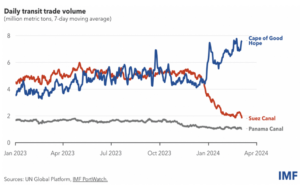
Does the Red Sea Disruption put a threat to Saudi giga-projects investments?
The disruption caused by the Red Sea crisis is evident across international shipping and supply chains. However, its specific effects on countries and sectors are now becoming clearer. In Saudi Arabia, the big question has been how this disruption will affect the supply of construction materials for major giga-projects on the west coast. This includes the Oxagon port, The Line at Neom, and the Red Sea Project. Houthi attacks in the Red Sea may have been disrupting the construction supply chain into Saudi Arabia but companies, in particular larger ones, are adapting to the challenge. Since November, the Yemeni militia has launched dozens of attacks on commercial vessels on their way to or from the Suez Canal, forcing many global shippers to reroute around South Africa’s Cape of Good Hope at higher costs and delays. The threat to the steady flow of resources, materials and goods around the world is happening just as demand surges in Saudi Arabia, where giga projects valued at around USD 1 trillion are under way. |
The disruption in commercial shipping has led to a significant 25-50% increase in construction material prices in recent weeks. This price surge coincides with heightened tensions in the Red Sea, reversing earlier perceptions of reduced risk due to increased naval presence. The situation intensified on February 18th with the sinking of the UK-owned Rubymar, which was carrying Saudi fertilizer. Another blow came on March 6th with the strike on the bulk carrier True Confidence, loaded with steel and vehicles from China. Industry suppliers, shippers, and logistics firms are facing tough decisions as they strive to meet the demands of Saudi Arabia's booming construction sector. Navigating the Gulf of Aden route has become increasingly risky, with war risk insurance premiums soaring to ten times their usual cost, reaching up to 1% of vessel value. An alternative is to transport materials overland from Asia to Saudi Arabia's eastern coast, which carries less risk but higher transport costs due to the inefficiency of moving bulky construction materials by road |
The Red Sea shipping disruptions caused by Yemen’s Houthi militants pose challenges but also unveil opportunities for the logistics sector in the Middle East. According to the recently released Agility Emerging Markets Index 2024, there are multiple investment and infrastructure development opportunities for Middle Eastern countries in the logistics sector. The index notes that the UAE and Saudi Arabia, with their robust infrastructure, are poised to capitalize on shifting global dynamics. As India and China vie for dominance as world logistics and manufacturing hubs, Middle Eastern countries can position themselves as vital hub locations connecting Southeast Asia, India, Africa, and parts of Europe. This situation underscores the importance of the USD 7 bn Saudi Landbridge project, which will provide a viable solution in the future by connecting the west and east coasts via rail. As the Red Sea disruptions present immediate challenges, they also underscore the resilience and adaptability of Middle Eastern logistics. Countries in the region can capitalize on emerging opportunities in the global logistics landscape. But if the conflict persists, renegotiations in the coming months could lead to additional price hikes. |
هل تشكل أزمة البحر الأحمر تهديدًا لاستثمارات المشاريع الضخمة السعودية؟
تتضح آثار الاضطراب الناجم عن أزمة البحر الأحمر على الشحن البحري الدولي وسلاسل التوريد. ومع ذلك، بدأت تظهر آثارها المحددة على الدول والقطاعات الآن بوضوح. في السعودية، كان السؤال الكبير هو كيف ستؤثر هذه الاضطرابات على إمدادات مواد البناء للمشاريع الضخمة على الساحل الغربي. ويشمل ذلك ميناء أوكساجون، ومشروع ذا لاين في نيوم، ومشروع البحر الأحمر. قد تكون هجمات الحوثيين في البحر الأحمر قد عطلت سلسلة الإمدادات للبناء إلى السعودية، ولكن الشركات، خاصة الكبيرة، تتكيف مع التحدي. منذ نوفمبر، شنت المليشيا اليمنية العشرات من الهجمات على السفن التجارية في طريقها إلى أو من قناة السويس، مما أجبر العديد من شركات الشحن العالمية على إعادة توجيهها حول رأس الرجاء الصالح في جنوب أفريقيا بتكاليف وتأخيرات أعلى. تأتي هذه التهديدات لتدفق الموارد والمواد والسلع حول العالم وسط زيادة الطلب في السعودية، حيث تجري مشاريع ضخمة تقدر قيمتها بحوالي 1 تريليون دولار. |
قد قُدر حجم الاضطراب في الشحن التجاري إلى زيادة ملحوظة بنسبة 25-50٪ في أسعار مواد البناء في الأسابيع الأخيرة. تتزامن هذه الزيادة الحادة مع تصاعد التوتر في البحر الأحمر، مع عكس التصورات السابقة للخطر المنخفض بسبب زيادة التواجد البحري. انقلب الوضع يوم 18 فبراير مع غرق السفينة البريطانية "روبيمار"، التي كانت تحمل أسمدة سعودية من الدمام إلى بلغاريا. وجاء ضرب السفينة الجافة "ترو كونفيدنس"، التي كانت محملة بالصلب والمركبات من الصين، في 6 مارس، كضربة أخرى. تواجه الشركات الموردة وشركات الشحن وشركات الخدمات اللوجستية قرارات صعبة في سعيها لتلبية مطالب القطاع البنائي المزدهر في السعودية. أصبح توجيه مسار البحر الأحمر أكثر خطورة، مع ارتفاع مبالغ تأمين الخطر الحربي إلى عشرة أضعاف تكلفتها العادية، وتصل إلى 1٪ من قيمة السفينة. البديل هو نقل المواد عبر البر من آسيا إلى الساحل الشرقي للسعودية، الأمر الذي يحمل أقل من المخاطر لكن يترتب عليه تكاليف نقل أعلى بسبب عدم كفاءة نقل مواد البناء الضخمة بكميات كبيرة عبر الطريق - الخيار الوحيد حاليًا. |
تُظهر الاضطرابات البحرية في البحر الأحمر التي تسببها ميليشيا الحوثي تحديات، ولكنها أيضًا تكشف عن فرص لقطاع اللوجستيات في الشرق الأوسط. وفقًا لمؤشر الأسواق الناشئة لعام 2024 الذي أصدرته شركة "أجيليتي" حديثًا، هناك فرص استثمارية وتطوير البنية التحتية متعدد ة لدول الشرق الأوسط في قطاع اللوجستيات. يشير المؤشر إلى أن الإمارات والسعودية، ببنيتهما التحتية القوية، مستعدتان للاستفادة من التحولات العالمية المتغيرة. بينما تتنافس الهند والصين على السيطرة كمراكز عالمية للخدمات اللوجستية والتصنيع، يمكن لدول الشرق الأوسط أن تضع نفسها كمواقع محورية مهمة تربط جنوب شرق آسيا والهند وأفريقيا وبعض أجزاء أوروبا. هذا الموقف يؤكد على أهمية مشروع السكك الحديدية السعودي البالغ 7 مليارات دولار، الذي سيوفر حلاً جديرًا في المستقبل من خلال ربط السواحل الغربية والشرقية عبر السكك الحديدية. وفيما يتعلق بالتحديات الراهنة التي تواجه الشحنات في البحر الأحمر، تؤكد على قدرة اللوجستيات في الشرق الأوسط على التأقلم والمرونة. يمكن للدول في المنطقة الاستفادة من الفرص الناشئة في منظومة اللوجستيات العالمية. ولكن في حال استمرار الصراع، قد تؤدي عمليات إعادة التفاوض في الأشهر القادمة إلى زيادة التكاليف. |
Subscribe to Publication
Subscribe to Download our daily roundup of economics and business








